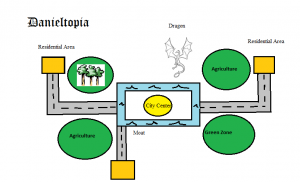The Third Wave (1895-1905)
Edward Bellamy– American author who wrote Looking Backward, in 1887.
- Society is based on socialism.
- Equality to all citizens.
- Money is valueless, you are given what is needed.
- Technology and mechanization leads to production.
- Centralized government.
- Influenced Ebenzer Howard.
Piotr Kroptin- The father of anarchism and author of Fields, Factories, and Workshop in 1898.
- Society is based on communism.
- Autonomous social units.
- Emphasis on agricultural rural life.
- Influenced Ebenezer Howard.
Theodor Fritsch- An anti-Semitic German publisher who wrote, Die Stadt der Zukunft in 1896.
- Anti-capitalist society.
- Medium sized towns.
- Open landscapes.
- Circular planning that concentrates around nucleus and grows outwards.
- Influenced Ebenezer Howard.
Our classes Utopia’s
- Danieltopia
- Zachtopia
Daniel’s vision of a utopia. Includes several agricultural zones for the production of food, and green zones for leisure and comfort. The city center, protected by a moat and ferocious dragon, contains the marketplace for trade and commerce. His residential areas are connected to the center through separate transportation networks.
Zachtopia:
- High density, but green-space is abundant.
- Universal Education and Health Care.
- Inhabitants earn opportunities by working towards it.
- Reformative justice.
- Legalization of alcohol and marijuana, but authority over harder substances
- Governed by science and logic.
- Social Democracy.
Josh had also shown plans for his ideal city. If you could please post your drawing it would be appreciated!
Discussion on Ebenezer Howard
Howard envisioned a low-density city of approximately 30,000 inhabitants within a one and half mile diameter. Agricultural land would take up 6,000 acres of land, while parks accounted for 145. Neighborhood units were to be self sufficient and easily accessible. Surrounding the city city was Greenbelts of 5,000 acres. He wished to marry the concepts of country and town within his Garden Cities to provide the comfort of rural life and the accessibility of urban centers.

